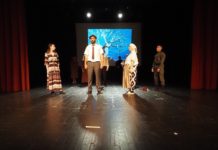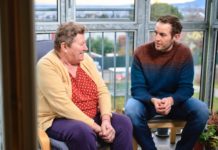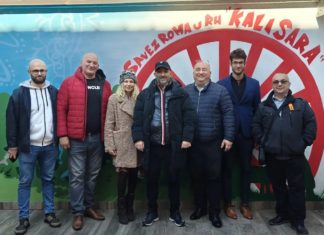Katarina Taikon, a Swedish actress, writer and activist, compared to Martin Luther King Jr. for her influence on Swedish society, is one of the icons of the struggle for Roma rights and one of Sweden’s greatest human rights fighters. Although she started on the margins of Swedish society and was formally educated only in her twenties, with her perseverance she brought the issues of the Roma in Sweden to the center of political decision-making, and with her series of engaged children’s books built around the girl Katitzi, she attracted an exceptionally large readership even beyond Sweden’s borders.
Salvation on the Stage
Katarina Taikon was born in 1932 in a camp near the city of Örebro as the youngest of four children of Johann Istvan Taikon, a Kalderash Roma whose ancestors came from Russia to Sweden at the turn of the 20th century, and Agda Karlsson, a Swede whom Johann met during one of his musical performances. Katarina started school only at the age of 10, but she could not seriously devote herself to it until after the end of the war. Katarina’s father had tried to enroll his children in school earlier, but he was regularly prevented from doing so either by local authorities or by other families who did not want their children to go to school with Roma.
At the age of 14, Katarina was, like her older sister Rosa a few years earlier, forced to marry. But instead of consenting to such a marriage, Katarina fled to a children’s shelter after a few months and was then transferred to an institution intended to help the homeless, where she managed to find a job and gain financial independence.
In 1948, Arne Sucksdorff, a significant Swedish documentary filmmaker and Sweden’s first Oscar winner, met Taikon in a Roma camp and offered her the lead role in his film Departure [Uppbrott], a ten-minute fiction film that portrays Roma life in a rather romanticized way. However, the film brought important positive things as the dialogues in the film were spoken in the Romani language and for the first time the Roma were not portrayed in a negative context on film. For Katarina, the film enabled her to leave an early forced marriage and opened the door to further artistic and public activity.
Over the next ten years, in addition to still having to work various short-term jobs for survival from time to time, Taikon increasingly performed in films and plays and began to move in urban artistic circles. In 1952, actor Per Oscarsson offered Katarina and her sister Rosa accommodation in his large house, where they first encountered the UN’s Declaration of Human Rights and the advocacy of the right to housing, employment and education, which, along with their increasing commitment to their own education, would be crucial for turning to political activism and working to improve Roma rights.
Turning to Activism
In 1958, Katarina enrolled in an adult school, and in the same year she met Bjorn Langhammer, a photographer whose artistic work dealt with the Roma and with whom Taikon would share an exceptionally close intellectual and political position for two decades.
The culmination of Taikon’s early phase of life can be considered the publication of her first book, Gypsy Woman [Zigenerska], in 1963, which was a great achievement in itself: it is the first book by a Romani author dealing with the living conditions of the Roma in Sweden. This autobiographical book sparked a lot of public debate and a reaction that something needed to be done about the discrepancy between the Swedish welfare state and the segregation of the Roma population. An external impetus that certainly further motivated Katarina was the murder of her brother Paul in 1962.
A year after the book’s publication, Taikon met Martin Luther King Jr., who came to Scandinavia to receive the Nobel Peace Prize. The same year, together with her sister Rosa within the “Roma Union” organization, she gathered numerous young activists and launched, among other things, a literacy course for adult Roma. Because the Swedish educational authorities did not want to fund further education for the participants, the “Roma Union” organized a series of protests culminating on May 1, 1965. The protests were successful and a delegation led by Katarina Taikon was invited to talk to Prime Minister Tage Erlander, which was the first case of a Roma delegation directly negotiating with a top government representative. As a result, ten adult schools were opened in Sweden within a year, and the program the protesters insisted on was included in the national education system. The Union also published its own magazine called We Live from 1965 to 1973, with a circulation of 3,000 copies. During those years, Taikon also published her second book titled We Are Gypsies.
With the abolition in 1954 of the provision banning immigration, many Roma refugees in Sweden sought protection and tried to start a new life. In 1967, the Swedish authorities turned to Katarina Taikon for help with the status of refugees from Poland and Italy. After an initial failure to allow the refugees to stay, a protest was organized that led to a new meeting with the minister at which it was decided that they would be allowed to stay after all.
However, two years later, a similar situation occurred, but with the opposite outcome: the Social Democratic government decided that a group of 47 French Roma would not be granted asylum and would have to leave Sweden. Although this decision would be reversed two years later, the deportation had an irreversible impact on Taikon’s stance on how to effect change in society. In the early 1970s, she decided to radically change her approach and focus on working with the youngest, believing that they were the engine of change in Swedish society.
The True Struggle for Justice Finds Its Way
The result of the decision to change her approach was a decade-long effort on a series of children’s novels titled Katitzi, centered around a girl of the same name. Drawing on her own experiences and touching on some important social and historical themes for the Roma community, primarily themes of injustice, ignorance, and exclusion, Taikon created a work that gained great popularity both in Sweden and abroad.
The audience and critics very quickly recognized the significance of the Katitzi stories, and as early as 1975, the stories began to be adapted into other media with the publication of a comic strip. In 1979, a television series was created, later followed by theatrical performances, and in 2019, the European Roma Institute for Arts and Culture (ERIAC) in Stockholm organized an extensive exhibition dedicated to Katitzi and her influence. As part of the exhibition, a series of seven short documentary films dedicated to the book and its author were produced. A notable biography of the author herself, titled The Day I Will Be Free, was published in 2012 by journalist and director Lawen Mohtadi, and based on that book, Mohtadi and journalist Gellert Tamas made a 2015 documentary film Taikon. The Untold Story of a Roma Freedom Fighter.
In 1981, a year after publishing the last installment of the series, Taikon divorced Langhammer. The following year, after a heart attack, she fell into a coma in which she spent thirteen years and from which she never awoke. She passed away in 1995 in the small town of Ytterhogdal.











